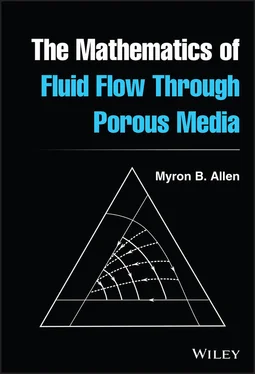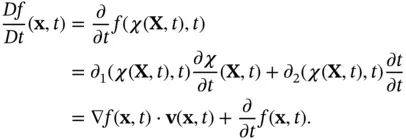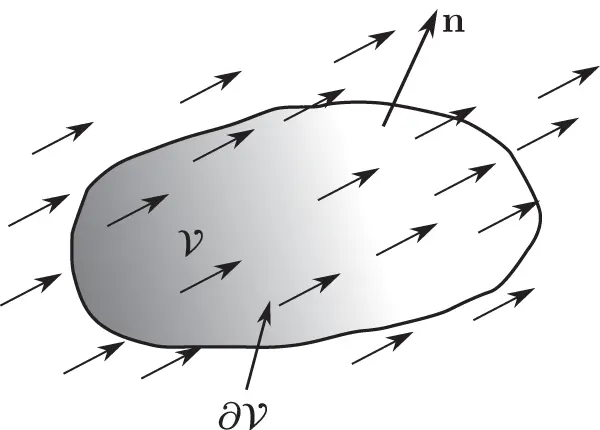Myron B. Allen, III - The Mathematics of Fluid Flow Through Porous Media
Здесь есть возможность читать онлайн «Myron B. Allen, III - The Mathematics of Fluid Flow Through Porous Media» — ознакомительный отрывок электронной книги совершенно бесплатно, а после прочтения отрывка купить полную версию. В некоторых случаях можно слушать аудио, скачать через торрент в формате fb2 и присутствует краткое содержание. Жанр: unrecognised, на английском языке. Описание произведения, (предисловие) а так же отзывы посетителей доступны на портале библиотеки ЛибКат.
- Название:The Mathematics of Fluid Flow Through Porous Media
- Автор:
- Жанр:
- Год:неизвестен
- ISBN:нет данных
- Рейтинг книги:5 / 5. Голосов: 1
-
Избранное:Добавить в избранное
- Отзывы:
-
Ваша оценка:
The Mathematics of Fluid Flow Through Porous Media: краткое содержание, описание и аннотация
Предлагаем к чтению аннотацию, описание, краткое содержание или предисловие (зависит от того, что написал сам автор книги «The Mathematics of Fluid Flow Through Porous Media»). Если вы не нашли необходимую информацию о книге — напишите в комментариях, мы постараемся отыскать её.
, distinguished professor and mathematician Dr. Myron B. Allen delivers a one-stop and mathematically rigorous source of the foundational principles of porous medium flow modeling. The book shows readers how to design intelligent computation models for groundwater flow, contaminant transport, and petroleum reservoir simulation.
Discussions of the mathematical fundamentals allow readers to prepare to work on computational problems at the frontiers of the field. Introducing several advanced techniques, including the method of characteristics, fundamental solutions, similarity methods, and dimensional analysis,
is an indispensable resource for students who have not previously encountered these concepts and need to master them to conduct computer simulations.
Teaching mastery of a subject that has increasingly become a standard tool for engineers and applied mathematicians, and containing 75 exercises suitable for self-study or as part of a formal course, the book also includes:
A thorough introduction to the mechanics of fluid flow in porous media, including the kinematics of simple continua, single-continuum balance laws, and constitutive relationships An exploration of single-fluid flows in porous media, including Darcy’s Law, non-Darcy flows, the single-phase flow equation, areal flows, and flows with wells Practical discussions of solute transport, including the transport equation, hydrodynamic dispersion, one-dimensional transport, and transport with adsorption A treatment of multiphase flows, including capillarity at the micro- and macroscale Perfect for graduate students in mathematics, civil engineering, petroleum engineering, soil science, and geophysics,
also belongs on the bookshelves of any researcher who wishes to extend their research into areas involving flows in porous media.


 denotes the gradient of the function
denotes the gradient of the function  , that is, its derivative with respect to the vector‐valued spatial position
, that is, its derivative with respect to the vector‐valued spatial position  . With respect to any orthonormal basis
. With respect to any orthonormal basis  , as drawn in Figure 2.4,
, as drawn in Figure 2.4,
 of spatial position and time, the material derivative is
of spatial position and time, the material derivative is

 having oriented boundary
having oriented boundary  and unit outward normal vector field
and unit outward normal vector field  . The small arrows represent the spatial velocity.
. The small arrows represent the spatial velocity. , called the mass density. This function gives the mass contained in any region
, called the mass density. This function gives the mass contained in any region  of three‐dimensional Euclidean space as the volume integral
of three‐dimensional Euclidean space as the volume integral
 . Here,
. Here,  denotes the element of volume integration. Since
denotes the element of volume integration. Since  is nonnegative, so is the mass. The expression (2.2)requires that
is nonnegative, so is the mass. The expression (2.2)requires that  .
. of three‐dimensional space exactly balances the rate of movement of mass across the region's boundary. In symbols,
of three‐dimensional space exactly balances the rate of movement of mass across the region's boundary. In symbols,
 denotes the boundary of
denotes the boundary of  ;
;  denotes the unit‐length vector field orthogonal to
denotes the unit‐length vector field orthogonal to  and pointing outward, as Figure 2.5depicts; and
and pointing outward, as Figure 2.5depicts; and  denotes the element of surface integration. We call the function
denotes the element of surface integration. We call the function  in the integral on the right side of Eq. (2.3)the mass fluxper unit area; the integrand
in the integral on the right side of Eq. (2.3)the mass fluxper unit area; the integrand  is the component of mass flux per unit area in the direction of the unit vector
is the component of mass flux per unit area in the direction of the unit vector  , that is, outward from
, that is, outward from  . The surface integral itself, together with the negative sign, is the net fluxof mass inward across
. The surface integral itself, together with the negative sign, is the net fluxof mass inward across  .
. that does not change in time. In this case,
that does not change in time. In this case,












